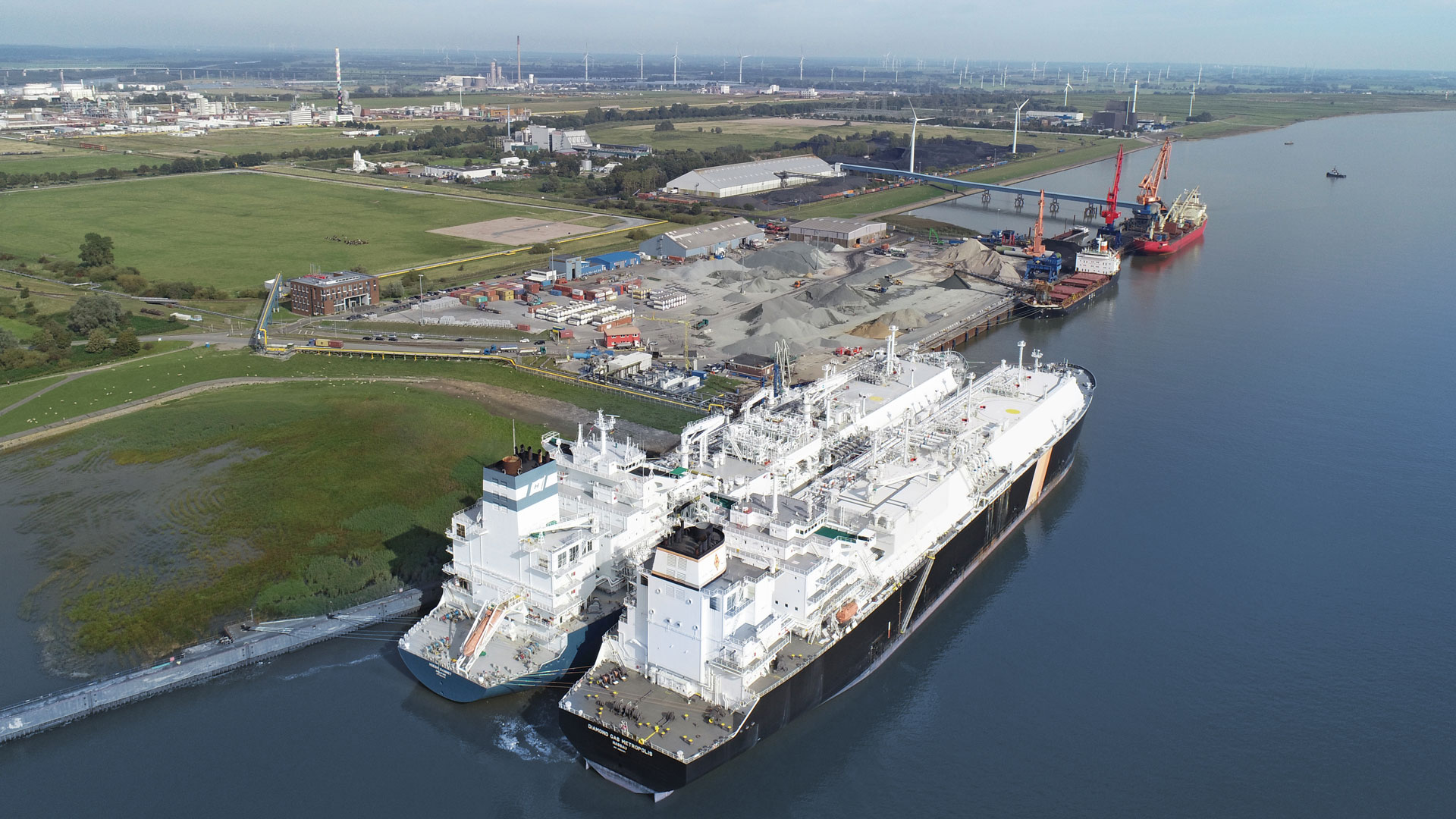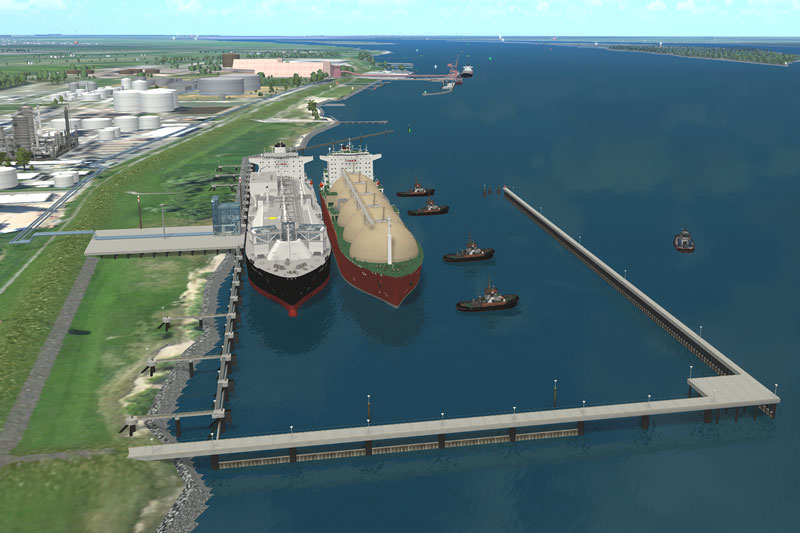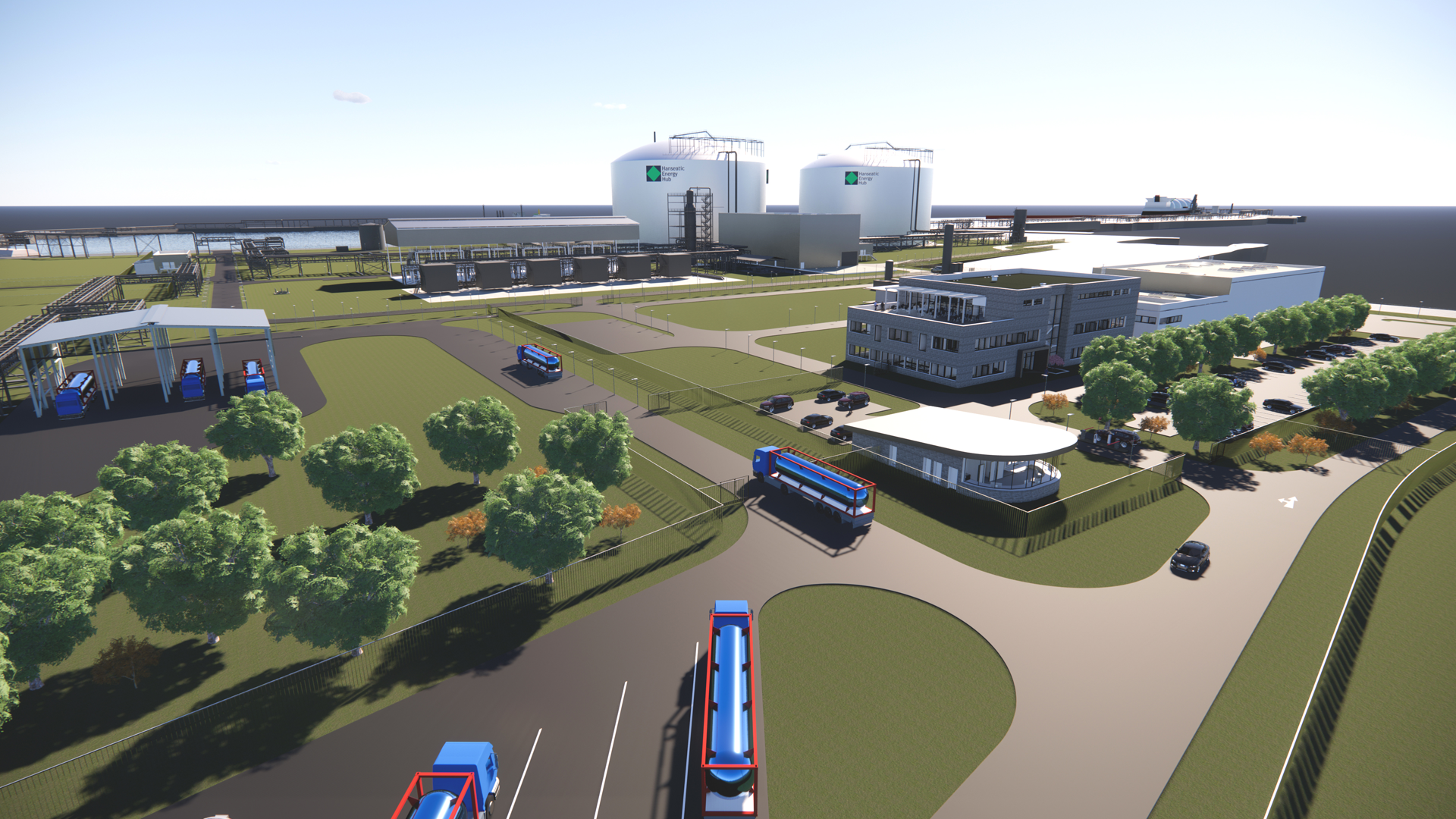Energy transition offers great opportunities for Port…
In this interview, Dr Melanie Leonhard, Senator for Economics and Innovation, explains how the Port of Hamburg intends to position itself ...

LLNG terminals play a crucial role in supplying natural gas for businesses, industries, and households. Brunsbüttel and Stade, two ports along the Elbe, have been jointly chosen as locations for LNG terminals. Brunsbüttel has been involved in LNG (liquefied natural gas) since 2011. "At the time, it was primarily intended to be used as fuel for ships," says Frank Schnabel, Managing Director of Brunsbüttel Ports.
At the beginning of 2023, the "Hoegh Gannet", a floating LNG terminal equipped with an FSRU (Floating Storage and Regasification Unit), was stationed in Brunsbüttel's Elbe port on behalf of the German government. This facility imports natural gas, regasifies it, and injects it into the German gas grid. FSRUs are considered a rapid solution to facilitate the import of substantial LNG quantities for Germany.
Measuring approximately 300 meters in length, the Hoegh Gannet can handle up to 170,000 cubic meters of LNG from tankers in a single offloading. With a regasification capacity of 750 million cubic feet per day, it translates to a network input of 3.5 to 5 billion cubic meters of natural gas annually. Permanently docked at Brunsbüttel, the Hoegh Gannet stores LNG at minus 161°C in tanks designed to withstand these extremely low temperatures. The terminal is commercially operated by DET - German Energy Terminal, acting under the commission of the German Federal Ministry of Economics and Climate Protection.
„The Hoegh Gannet
can hold 170,000
cubic metres
of LNG."
But why choose Brunsbüttel? The ChemCoast Park Brunsbüttel spans an extensive 2,000 hectares. Hosting nearly 4,500 jobs directly on-site, it stands as the largest industrial area in Schleswig-Holstein. Here, companies in the chemical and petroleum sectors, energy producers, logistics firms, and various other industries engage in production and trade. They all benefit from its strategic positioning along the River Elbe and the Kiel Canal, coupled with its proximity to the metropolis of Hamburg. With access to renewable energy, this location presents substantial potential, especially in the context of the energy transition.
"Our motivation was - and still is - the understanding that our efforts over the past year have significantly contributed to maintaining Germany's continued reliable gas supply," emphasizes Schnabel. The positive ripple effect of this work extending to the entire industrial area, which itself has a substantial gas demand, is highly beneficial for the companies located in Brunsbüttel. However, the task is far from complete. "Now that we have successfully navigated through the winter of 2022/23 with the assistance of LNG, all parties involved in the project, including the federal and state governments, authorities, and local representatives, are working tirelessly to ensure a smooth passage through the upcoming winter," he underscores.

LNG stands out as a valuable transitional technology in the journey towards energy transition, playing a crucial role in diversifying Germany's energy sources and creating a pathway for the eventual import of green energy sources. Schnabel highlights, "Especially after the loss of Russian gas supplies, establishing a versatile energy import infrastructure in Germany is essential to maintain a consistent gas supply for both industry and private households, independent of pipelines." In the long run, this infrastructure should also be used tp import green energy sources like green hydrogen or green ammonia as a hydrogen derivative.
Looking ahead, the Brunsbüttel energy port is actively preparing for the future. For instance, the German LNG Terminal Brunsbüttel is in the process of developing and operating a landside LNG terminal on-site. The vision involves landing green hydrogen or its derivatives in Brunsbüttel following the import of LNG. Additionally, the energy port has aspirations to produce green hydrogen internally, ensuring a sustainable supply for the decarbonized industries of the future.

Brunsbüttel plays a crucial role in the energy infrastructure of northern Germany, making significant contributions to energy supply, economic development, and environmental protection, thereby benefiting Hamburg as well. Schnabel highlights, "The port locations of Brunsbüttel and Hamburg have fostered a close and trusting partnership for many years, aiming to position and shape the Lower Elbe economic region for the future." Both locations complement each other with their unique strengths and potential, providing mutual support in overcoming a variety of challenges.
A new FSRU is also due to be moored in Stade at the end of 2023. The Transgas Force, owned by shipping company Dynagas, is one of five floating LNG terminals chartered by the government and operated by state-owned Deutsche Energy Terminal (DET). Stretching 294 meters in length, it holds 174,000 cubic meters of LNG, equivalent to six billion cubic meters of natural gas annually. With an estimated household consumption of around 20,000 cubic meters per year, this could cater to 300,000 households. The FRSU will utilize the existing infrastructure at the planned onshore terminal and will be connected to the German gas grid through a very short pipeline.
Meanwhile, construction is underway for the Hanseatic Energy Hub (HEH) in Stade, an independent and flexible LNG import terminal. Shareholders in this privately financed project include the Hamburg-based Buss Group, Spanish company Enagás, Swiss Partners Group, and the chemical company Dow. The HEH, situated on the existing industrial estate in Stade, will function as a zero-emission terminal, utilizing Dow's waste heat for regasification. Boasting nearly 50 years of experience with liquefied gases at the site, HEH guarantees the highest safety standards.
Dr. Johann Killinger, co-partner and managing director of HEH, explains, "With the HEH, an import terminal is being constructed in Stade to secure Germany's supply of LNG and green gases while simultaneously preparing the market for hydrogen." The land-based terminal is expected to be ready for ammonia in 2027. He adds, "The basis for this is a future-flexible modular system for the transition to green energy, offering a wide range of options for visualizing the planned import terminal in the port of Brunsbüttel, an energy region in the areas of chemicals, logistics, and the energy industry."
For HEH, Stade Industrial Park is ideally located on the River Elbe with access to both the North Sea and the Port of Hamburg, not far from two major motorways and Europe's largest marshalling yard at Maschen. Liquefied gases can be distributed by ship, truck, and, in the future, by rail. Pipelines also provide access to the German gas network. The port itself is capable of accommodating the largest LNG tankers, measuring up to 345 meters in length. Smaller tankers can load LNG and ammonia here for delivery to other inland waterway ports or immediate bunkering for ships in Hamburg, on the Elbe, or in the Kiel Canal.
And why LNG? It is transportable and facilitates the diversification of gas supplier countries. Experts see LNG as an important alternative to pipeline gas. Additionally, LNG is a low-emission fuel for shipping and heavy goods vehicles, emitting minimal particulate matter, no sulfur dioxide, and up to 85% less nitrogen oxide. Looking ahead, there is potential to produce climate-neutral LNG as synthetic LNG, based on renewable energy and using the power-to-X process, converting excess electrical energy into hydrogen or synthetic fuels.
Nevertheless, concerns exist regarding potential methane emissions from the transport and liquefaction of gas, adding to environmental burdens. Critics worry that reliance on LNG could increase dependence on imports, especially from countries outside Europe. They also argue that heightened support for LNG might impede the development of renewable energy sources.
LNG is a non-toxic, colourless and odour-free liquid. The abbreviation LNG stands for Liquefied Natural Gas. Liquified at minus 162 degrees Celsius and under atmospheric pressure, it takes up only 1/600 of its gaseous volume. This makes it simple to transport and store. This is achieved without loss or additional cooling, thanks to the state-of-the-art insulation materials used for ship and storage tanks. The same applies to bio-LNG and SNG, a synthetically produced LNG. Source: HEH